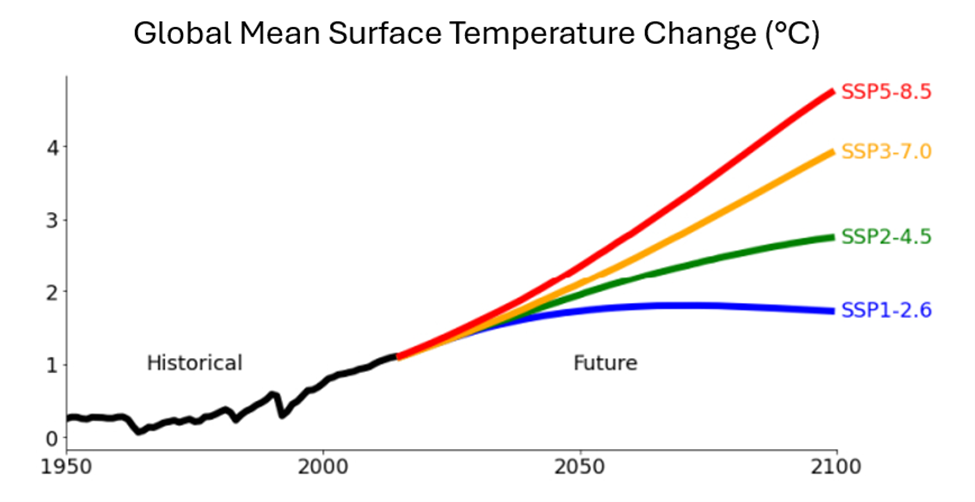The ClimateData.ca team is working on a site-wide update to its future climate model offerings. Currently, the platform utilizes a dataset known as Canadian Downscaled Climate Scenarios Univariate CMIP6 (CanDCS-U6), or just U6 for short. Later this year, the site will switch to CanDCS-M6, or M6 for short. This new dataset employs a new statistical method known as MBCn and utilizes a different target dataset called PCIC-blend, offering several enhancements and enabling new use-cases compared to U6. This article outlines the technical advancements of the M6 data and underscores the importance of its impending release for all ClimateData.ca users.
Backgrounder: U6 and M6 datasets on ClimateData.ca
CanDCS-U6
Almost all the future temperature and precipitation climate model data presently available on ClimateData.ca comes from a statistically downscaled dataset known by climate scientists as CanDCS-U6, or just U6 for short. The “U” stands for univariate, and the “6” for CMIP6. Throughout ClimateData.ca, users will also see this dataset referred to as “BCCAQv2” or “CMIP6”. BCCAQv2 references the specific statistical technique used to compute the U6 data. The BCCAQv2 technique has been shown to be effective for downscaling daily temperature and precipitation from various climate models. Each climate variable is adjusted separately which, while effective, does not capture interactions between different climate variables.
As climate scientist Carrington Pomeroy with the Canadian Centre for Climate Services (CCCS) explains: “One defining characteristic of this downscaling technique can be found in the name of the dataset. ‘Univariate’ means that the technique is only applied to one variable at a time. This means that temperature and precipitation are downscaled separately and therefore, the relationships between these two variables aren’t considered when downscaling.”
This limitation means that the U6 data are less suitable for some types of calculations, such as Humidex, the Standardized Precipitation Evapotranspiration Index (SPEI), snowfall, and fire weather.
CanDCS-M6
Here, the “M” stands for multivariate. The M6 dataset was downscaled using a statistical technique called MBCn. Some of the newer data products on ClimateData.ca (like Humidex and SPEI) were already developed using this technique. This method considers multiple variables simultaneously, not just correcting them independently, preserving the relationships amongst them. This is especially important for complex climate phenomena that involve interactions between temperature and precipitation, including the Humidex, SPEI drought index, snowfall, and fire weather variables mentioned above.
A new target dataset
To downscale climate model projections – going from the raw scale of global climate models down to a scale appropriate for local adaptation planning – you need a target dataset, an accurate and detailed reconstruction of the actual historical climate over Canada.
The new M6 dataset does not only use a different statistical method compared to U6, but it also references a different ‘target dataset.’
M6 uses the PCIC-Blend dataset as its new downscaling target. This dataset blends several observational grids to adjust known biases, particularly the dry precipitation bias on Canada’s west coast. This results in improved data accuracy and reliability for climate studies. This replaces the old target dataset, referenced in the U6 data, known as ANUSPLIN or NRCANMET.
Phasing out U6
The ClimateData.ca team is now in the final stages of replacing all U6 data with M6 data. This means that all the maps, time series plots, downloads, and custom analyses will reference the new M6 data. The previous U6 data will no longer be available through the site; however, efforts are being made to keep a copy of these data on PAVICS.
Unlocking new analyses and use-cases
The ClimateData.ca team is excited to share M6 with all Canadians. The team has a lot of ambitious plans for how to best use these new data. As alluded to above, new snowfall data will be made available soon, fulfilling a long-time user need. The new data also allows for the calculation of return periods, which will again start to roll out on the site in the coming months. Be sure to stay subscribed so you don’t miss these important updates.
One more thing: SSP3-7.0
While pushing the new M6 data live, the team is also taking the opportunity to add one more emission scenario to the site: SSP3-7.0. Here, SSP stands for shared socio-economic pathways. You can learn all about SSPs by reading this learning zone article. The SSP3-7.0 scenario sits between SSP5-8.5 – the scenario that results in the most climate warming by end of century on ClimateData.ca – and SSP2-4.5, sometimes referred to as the ‘middle of the road’ scenario. The SSP3-7.0 scenario is another ‘high’ climate change scenario. It is one of the scenarios referenced frequently by Ouranos on their Climate Portraits web portal. To ensure a consistency of data offerings across all our partners’ sites and to ensure ClimateData.ca contains the scenario best suited for your work, no matter where you live, we are very pleased to offer the new SSP3-7.0 scenario to all Canadians.
Stay connected to learn more
Be sure to subscribed to our newsletter and follow us on social media to ensure you are informed when the new M6 data goes live.
Short Survey: we want to hear from you
Your opinions matter to us. If you are a current user of ClimateData.ca, please take a few minutes to complete this short survey. This will help us understand how the changeover from U6 to M6 data might impact your work.
References and further reading
Cannon, A. J., 2018: Multivariate quantile mapping bias correction: an N-dimensional probability density function transform for climate model simulations of multiple variables. Climate Dynamics, 50, 31-49, doi:10.1007/s00382-017-3580-6.
Pacific Climate Impacts Consortium (PCIC), University of Victoria, (July 2023). Statistically Downscaled Climate Scenarios. Downloaded from https://data.pacificclimate.org/portal/downscaled_cmip6/map/ on 2/14/2024. Method: MBCn.

